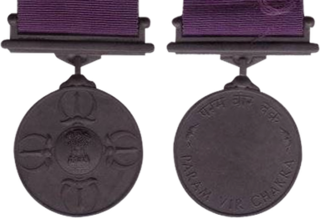
The Param Vir Chakra (PVC) is India's highest military decoration, awarded for displaying distinguished acts of valour during wartime. Param Vir Chakra translates as the "Wheel of the Ultimate Brave", and the award is granted for "most conspicuous bravery in the presence of the enemy". As of January 2018, the medal has been awarded 21 times, of which 14 were posthumous and 16 arose from actions in Indo-Pakistani conflicts. Of the 21 awardees, 20 have been from the Indian Army and one has been from the Indian Air Force. Major Somnath Sharma was the first recipient. A number of state governments of India as well as ministries of the central government provide allowances and rewards to recipients of the PVC.

The Lahaul and Spiti district in the Indian state of Himachal Pradesh consists of the two formerly separate districts of Lahaul and Spiti. The present administrative center is Kyelang in Lahaul. Before the two districts were merged, Kardang was the capital of Lahaul, and Dhankar the capital of Spiti. The district was formed in 1960 and is the fourth least populous district in India. It is the least densely populated district of India, according to the Census of India 2011.

The Maha Vir Chakra (MVC) is the second highest military decoration in India, after the Param Vir Chakra, and is awarded for acts of conspicuous gallantry in the presence of the enemy, whether on land, at sea or in the air. It replaced the British Distinguished Service Order (DSO). The medal may be awarded posthumously.
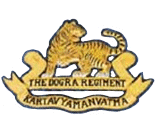
The Dogra Regiment is an infantry regiment of the Indian Army. The regiment traces its roots directly from the 17th Dogra Regiment of the British Indian Army. When transferred to the Indian Army like its sister regiments, the numeral prefix was removed. Dogra Regiment Units Maximum filled with Rajputs And Sikh. Units of the Dogra Regiment have fought in all conflicts that independent India has been engaged in, making it one of the most prestigious and most decorated regiments of the Indian Army.
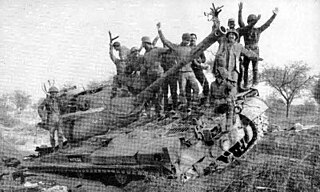
The Battle of Basantar, also known as the Battle of Shakargarh or Battle of Barapind, was one of the vital battles fought as part of the Indo-Pakistani War of 1971 in the western sector of India. The Indian troops won a hard-fought battle that secured this area in the Punjab/Jammu sector. The name Battle of Basantar actually encompasses the entire gamut of battles and skirmishes fought in the Shakargarh sector.
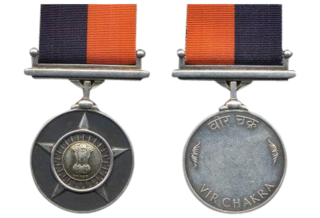
The Vir Chakra is an Indian wartime military bravery award presented for acts of gallantry on the battlefield, on land or in the air or at sea.
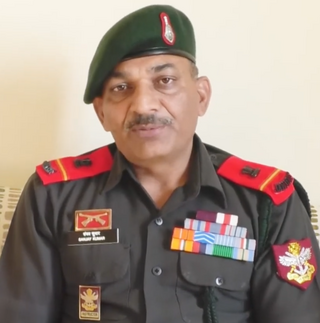
Subedar Major Sanjay Kumar PVC is an Indian Junior Commissioned Officer, and recipient of the Param Vir Chakra, India's highest military award for his exemplary bravery during Kargil War. He is the only PVC awardee who is currently serving.
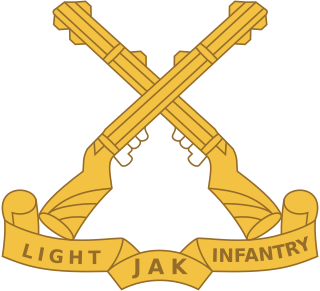
The Jammu and Kashmir Light Infantry is an infantry regiment of the Indian Army. The regimental center is in Srinagar's Airport Complex at Awantipora with a winter setup near Jammu. Its regimental insignia consists of a pair of crossed rifles. The regiment mostly consists of volunteers from the state of Jammu & Kashmir and ethnic groups from the state. The Jammu and Kashmir Light Infantry is considered to be one of the most decorated regiment of the Indian army having won 1 Param Veer Chakra and 3 Ashok Chakra. Naib Subedar Chuni Lal of the 8th battalion Jammu and Kashmir Light Infantry is one of the most decorated personnel of the Indian Army.
Colonel Chewang Rinchen MVC & Bar, SM was a highly decorated officer in the Indian Army from the Union territory of Ladakh. He was the youngest ever recipient of the Maha Vir Chakra, the second highest Indian gallantry decoration, for his role in the defence of Ladakh in the First Kashmir War. He received the Maha Vir Chakra for a second time after Indo-Pakistani War of 1971, for his role in the conquest of the Turtuk and Tyakshi, in what came to be known as the Battle of Turtuk. He was one of only six Indian service personnel to have the Maha Vir Chakra twice. He was awarded a Sena Medal for gallantry in the 1962 India-China War. and Mention in dispatches for gallantry in the Indo-Pakistani War of 1965

Subedar and Honorary Captain Karam Singh PVC, MM was an Indian soldier and a recipient of the Param Vir Chakra (PVC), India's highest award for gallantry. Singh joined the army in 1941, and took part in the Burma Campaign of World War II, receiving the Military Medal for his actions during the Battle of the Admin Box in 1944. He also fought in the Indo-Pakistani War of 1947, and was awarded the PVC for his role in saving a forward post at Richhmar Gali, south of Tithwal. He was also one of the five soldiers chosen to raise the Indian flag for the first time after independence in 1947. Singh later rose to the rank of subedar, and was conferred the rank of honorary captain before his retirement in September 1969.
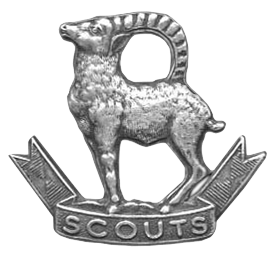
The Ladakh Scouts is a mountain infantry regiment of the Indian Army, nicknamed as the "Snow Warriors" or "Snow Leopards". The regiment specializes in cold-weather warfare and mountain warfare, long-range penetration, maneuver warfare, raiding with small unit tactics, and reconnaissance in difficult to reach and dangerous terrain. Its primary role is to guard India's borders in the high altitudes of the Union Territory of Ladakh.
Colonel Sonam Wangchuk, MVC is an Indian Army veteran, who served with the Assam Regiment and the Ladakh Scouts. He was awarded the Maha Vir Chakra, India's second highest award for gallantry in the face of the enemy, during his successful operation in the Kargil War. Due to his exemplary feet as a Major during Kargil War, he is known as the Lion of Ladakh in the Indian Army.

Bapora is a village in the Bhiwani district of the Indian state of Haryana. There is a Tomb of Sant Baba bhagwan Dass ji who was famous palmist. It lies approximately 7 kilometres (4.3 mi) west of the district headquarters town of Bhiwani. As of the 2011 Census of India, the village had 1,657 households with a total population of 34,332 of which 17,651 were male and 16,681 female. The major population of area is Brahmin and Rajput.

Brigadier Rajinder Singh Jamwal, MVC, also remembered as the Saviour of Kashmir, was an officer in the Jammu and Kashmir State Forces. He briefly served as the Chief of Staff of State Forces and died fighting during the First Kashmir War. Rajinder Singh and his small contingent of about 100 men successfully delayed the advance of a 6000 strong force of Pakistani tribal raiders near Uri for several days, during which the Maharaja of Kashmir acceded to India and the Indian forces air-lifted for the defence of Kashmir.
Commodore Babru Bhan Yadav, MVC, also known as B.B. Yadav, was a former Indian Navy Officer. He led the 25th Missile Boat Squadron during Operation Trident in the Indo-Pakistani War of 1971.
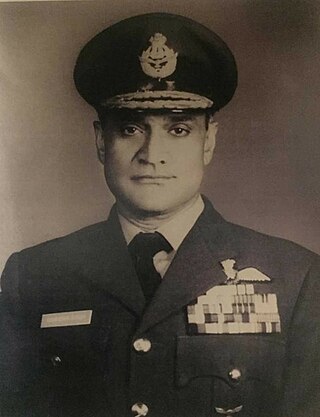
Air Vice Marshal Chandan Singh, MVC, AVSM, VrC was an Air Officer in the Indian Air Force. A highly decorated officer, Singh was awarded the Vir Chakra during the Sino-Indian War and the Maha Vir Chakra during the Indo-Pakistani War of 1971.
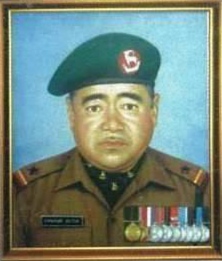
Naib Subedar Chhering Mutup, AC is a retired Junior Commissioned Officer (JCO) with the Ladakh Scouts who was awarded the Ashoka Chakra, India's highest peacetime military decoration.

Colonel Thakur Prithi Chand, MVC, was an officer of the Indian Army. He is known for his significant role in stalling Pakistani advances in Ladakh during the Indo-Pakistan War of 1947-48. For his role in this war, Thakur Prithi Chand is regarded among the 'Saviours of Ladakh', alongside Kushal Chand, Bhim Chand, and Chewang Rinchen.
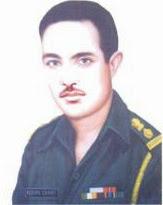
Lieutenant Colonel Kushal Chand, MVC, was an officer of the Indian Army. He is known for his significant role in stalling the progress of Pakistani forces into Ladakh, during the Indo-Pakistan War of 1947-48. For his role in this war, Thakur Kushal Chand is regarded among the 'Saviours of Ladakh', alongside Thakur Prithi Chand, Bhim Chand, and Chewang Rinchen.
















